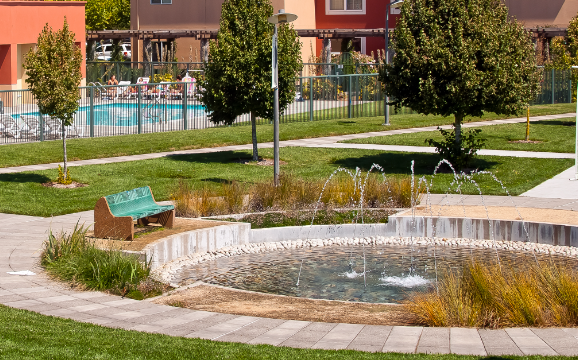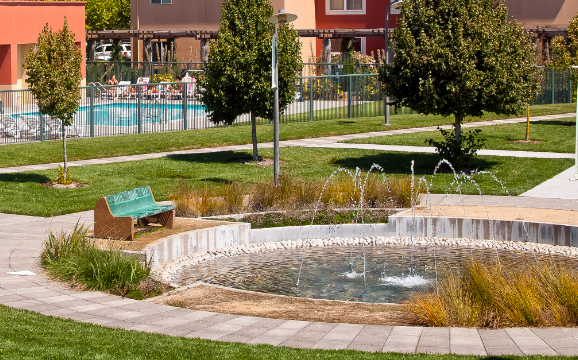On Aug. 24, the Sonoma State University Beaujolais Village fountain was vandalized by soap causing bubbles to grow and escape the fountain’s cement. This was an isolated incident however if the vandalism occurred elsewhere, these pollutants such as soap could be detrimental to the health of local ecosystems.
Under normal circumstances the fountain is a closed off water source, however the introduction of soap created bubbles which overflowed the base of the fountain, leading to potential runoff. With the presence of a vast irrigation system on campus, as well as life forms that utilize the various on campus ponds or the nearby creeks, potential runoff could have devastating effects.
SSU is host to a variety of species on campus including reptiles, amphibians, birds, and mammals, who might be at risk for environmental pollution.
The biggest concern when it comes to aquatic ecosystems and soap pollution is the effects it has on the pH level of the environment. The Indian Journal of Dermatology wrote in an article, “Most soaps have a pH within the range of 9-10.”
Reports from the Environmental Protection Agency (E.P.A.) state, “pH level is one of the most important environmental factors limiting species distributions in aquatic habitats. Different species flourish within different ranges of pH, with the optima for most aquatic organisms falling between pH 6.5-8.” A consistent pH is vital for healthy animal reproduction, growth, and biological diversity. Fluctuations caused to the environment by the introduction of pollutants like soap physiologically stresses species leading to an increase in disease and death.
The Beaujolais fountain may not be a stream, but nevertheless it is in close vicinity to Copeland Creek which serves as an aquatic ecosystem for amphibians, birds, and aquatic insects species alike.
Amphibians, especially frogs, are particularly susceptible to contaminants. The Journal of Toxicologic Pathology said frogs have, “thin, permeable skin and inhabit aquatic environments, so they are exposed to toxicants through both dermal and dietary routes.”
According to the U.S. Geological Survey (U.S.G.S) website, “the average decline rate amongst amphibian populations in the United is 3.79% per year.” If this rate continues, the U.S.G.S. calculates that some species will disappear from half of the habitats they occupy in roughly 20 years.
Decline in animal population isn’t the only thing impacted by potential soap pollution. The introduction of detergents and other types of soaps into an aquatic environment can lead to a phenomenon known as eutrophication.
The Nature Education Knowledge Project explained eutrophication in an article, “Eutrophication is characterized by excessive plant and algal growth due to the increased availability of one or more limiting growth factors needed for photosynthesis, such as sunlight, carbon dioxide, and nutrients.” Also, the increase in photosynthesis due to the higher presence of algae can reduce dissolved inorganic carbon and raise pH to dangerous levels during the day.
Phosphates are present in many common household soaps and detergents. An article published by NYC Environmental Protection explained phosphorus concerns related to detergent use. Soaps and detergents act as fertilizers which encourages the growth of algae. This algae growth then leads to the reductions of the water’s oxygen levels.
These oxygen levels are essential to the aquatic organisms living in a given ecosystem, and lower oxygen levels inhibit the process of cellular respiration, possibly leading to the deaths of organisms within it.
This only places further strain on the aquatic ecosystem, and has detrimental effects on the organisms living within it.
SSU student, Chris Straus, saw the fountain of bubbles and initially thought it was funny. Straus said, “There did seem to be a ridiculous amount of bubbles. It seemed like a waste of soap to me.”
Student Rene Cassano expressed concern for the animals possibly affected by this vandalism. “I’ve definitely seen and heard frogs and ducks around the fountains; a layer of soap doesn’t seem to be good for them.”
COURTESY //
SSU Beaujolais Village fountain when it’s operating normally. Someone vandalized it with soap before the fall semester began.
COURTESY // housing.sonoma.edu
Beaujolais Village fountain was vandalized with soap prior to the start of the semester. The image above is of the fountain when it is soap free.





![[Both photos courtesy of sonoma.edu]
Ming-Ting Mike Lee stepped in as the new SSU president following Sakakis resignation in July 2022](https://sonomastatestar.com/wp-content/uploads/2024/04/CC4520AB-22A7-41B2-9F6F-2A2D5F76A28C-1200x1200.jpeg)



























